COBRA - Background Information
- Introduction
- Rationale
- Field site, Measurements and techniques, and Deliverables
1 - Introduction
Throughout the Arctic and Antarctic coastal regions, episodes of rapid ozone and mercury depletion
occur every spring. These events can be sustained (occurring over periods of days to weeks) and can
extend from the surface up to ~2.5 km (Roscoe et al., 2001; Bottenheim et al., 2002). Tropospheric
ozone is a significant greenhouse gas, whilst mercury is a toxic, persistent and bioaccumulative
pollutant, thus these phenomena have implications for the atmospheric oxidative capacity, climate and
health. The observed rapid and dramatic ozone and mercury depletion at polar sunrise (with less
frequent and dramatic events during autumn) is mediated by exchange of halogen species between the
snowpack and sea-ice surface and the overlying atmosphere, yet many aspects of the underlying
chemistry and physics are not well understood. The halogen species may also impact Arctic haze by
enhancing photochemical reactions which produce fine aerosol. Since the nature and extent of snow and
ice cover in polar regions is now changing at a significant rate (Yu et al., 2004), and this appears to be
reflected in the magnitude and extent of ozone and mercury depletion events (Hollwedel et al., 2004), it
is imperative to develop a quantitative understanding of the relevant ocean-snow-ice-atmosphere
interactions, in order to predict the future state of the Arctic (and Antarctic) atmosphere and its relation
to climate, health, and environmental change. Such improved knowledge is also relevant for processes
occurring in lower-latitude winter environments.
2 - Rationale
2.1 - Previous work on polar bromine release and ozone and mercury depletion events
The key role played by bromine in ozone and mercury depletion events has been described in numerous
studies (Bottenheim et al., 1986; Schroeder et al., 1998; Bottenheim et al., 2002; Spicer et al., 2002, and
references therein). The suggested autocatalytic heterogeneous mechanism involves uptake of HOBr into
slightly acidic and concentrated brines (containing enhanced Br- and Cl-) on sea-ice/snow-pack/sea-salt
aerosol surfaces resulting in release of gaseous Br2 and BrCl, which are rapidly photolysed to bromine
atoms:
| | aqueous phase, ice | | | |
| HOBr + X- + H+ | → | BrX + H2O | , | where X = Br, Cl. |
Every HOBr molecule entering the liquid phase has the potential to release two bromine atoms to the
gaseous phase, resulting in an exponential increase of Br, the so-called "Bromine explosion".
The resulting photolysable BrX molecules rapidly produce Br atoms that enter various ozone-destroying
cycles:
| Cycle I | | | Cycle II |
| 2Br + 2O3 → 2BrO + 2O2 | | | Br+O3 → BrO + O2 |
| BrO + BrO → 2Br + O2 | | | BrO + HO2 → HOBr + O2 |
| | | | HOBr + hv → Br + OH |
| | | | OH + CO (or VOC) → HO2 + CO2 (or VOC products) |
Cycle I will dominate at high BrO levels, and cycle II at low BrO levels. The re-formation of soluble
HOBr(g) in Cycle II, which re-enters the aqueous phase either through uptake on sea-salt aerosol or direct
deposition to the snow-pack/sea-ice, results in an autocatalytic mechanism.
Schroeder et al. (1998) first observed the rapid decrease in Hg atoms, now referred to as "MDEs"
(mercury depletion events) in the Arctic. The MDEs are accompanied by increases in oxidised, but so
far unspeciated, mercury in the snowpack, potentially leading to bioaccumulation of soluble and toxic
forms of mercury. Recent measurements of the rate coefficients for reactions of a number of halogen
gases with Hg suggested that Br atoms could be a major reactant with Hg in the polar atmosphere (Ariya
et al., 2002), and subsequent studies have supported this (e.g. Calvert and Lindberg 2004a; Goodsite et
al., 2004; Skov et al., 2004). BrO may also be an important reactant, but there are insufficient studies on
its rate of reaction with Hg vapour and its concentration in the polar boundary layer. There has been a
recent increase in Hg in the Arctic biosphere, and it has been hypothesized that this results primarily
from increases in atmospheric oxidant levels and/or reactive bromine rather than from an increase in Hg
emissions (OASIS science plan).
It has been suggested that ozone and mercury depletion events apparently operate almost exclusively in
polar spring either (a) because only this season has the combination of strong surface inversions (i.e.
isolation of boundary layer air from free tropospheric air), sunlight and sea ice (Lehrer et al., 2004), or
(b) because the asymmetry of sea ice/frost flower production compared to the amount of sunlight leads to
a strong spring maximum in their product (Kaleschke et al., 2005). However, both of the proposed
drivers for this seasonality, and the initial source of bromine atoms required to form HOBr and thus
initiate the chain destruction of ozone, are controversial.
2.2. - Potential role of frost flowers and other surfaces for halogen release
There is substantial evidence that sea salt, either on the sea-ice or snow-pack surface or contained in
aerosol, is almost exclusively the source of bromine liberation in polar regions. The high salinity and
surface area of frost flowers, which are ice crystals that grow on newly forming sea ice, along with their
widespread occurrence as part of the normal process of new sea ice formation, has recently led to
proposals that they may be an important part of this process (e.g. Rankin et al., 2002). From an analysis
of satellite BrO data and sea ice coverage, Kaleschke et al. (2004) showed that areas potentially covered
in frost flowers (FF), i.e. with cold temperatures and open leads, are plausibly the dominant source of
bromine in both the Arctic and Antarctic. The exact nature of emissions from frost flowers is not well
established and is not yet explicitly treated in global models, and so far there are no in situ field
observational studies to confirm or otherwise the important role of FF in bromine release. It is vital that
field data is obtained on the nature and magnitude of emissions of halogens as a function of age and type
(air/sea-ice differential temperature) of frost-flowers and other sea-ice surfaces, in order to predict the
spatial and temporal variability of halogen release, and how this might change in the future.
Brines and frost flowers themselves may be responsible for a significant fraction of sea salt aerosol
concentrations over the polar regions (Rankin et al., 2002). However, under typical Arctic conditions,
even a flat sea-ice surface (i.e., no frost flowers) provides a factor of ~1000 higher surface area than sea
salt aerosol (Lehrer et al., 2004). The latter modelling study of Lehrer et al. (2004), although highly
parameterised, found that sea salt aerosol alone was not sufficient to sustain the elevated levels of gas
phase bromine observed in polar spring, although is an efficient recycler of more stable bromine species
such as HBr. However, the study of Evans et al. (2003) was able to adequately simulate the chemistry
occurring within an ODE through the use of aerosols alone. Thus there are competing hypotheses for the
relative role of the surface and aerosol phase in the production and recycling of bromine. The full suite
of analytical tools we will deploy during COBRA will allow these hypotheses to be tested more
thoroughly than previous studies have allowed.
2.3 - Potential sources and role of iodine in the Arctic
Little is known about the role and sources of iodine in polar boundary layer chemistry. Iodinecontaining
aerosol has been associated with ozone depletion at polar sunrise but also appears in autumn.
A well-known and obvious source of iodine compounds are under-ice diatoms, which grow there
particularly well because of the benevolent light conditions through less than 1 m of ice, compared to
those of open water where they are mixed downward to depths of tens of metres. Many diatoms
synthesise methyl iodide and other organic iodine compounds, and the chlorophyll they produce is
observable from space in large quantities in open water in the sea ice zone in early summer. However,
recent work has suggested abiotic/photochemical sources of iodine in the sea ice zone. In a 10-month
campaign at Halley station, Antarctica, the iodine oxide radical, IO, was observed using a boundary layer
DOAS (Differential Optical Absorption Spectrometer) (A. Saiz-Lopez and J. M.C. Plane, part of the
COBRA team, unpublished data). A clear seasonal cycle was observed: IO was below the detection
limit (~1.5 ppt) during polar night, and reached levels of several ppt during spring and summer.
Preliminary modelling indicates that the source of the iodine during summer is likely to have been
emission from the snowpack, arising from photochemical or thermal processes, rather than directly from
the ocean.
Further evidence of iodine in the polar atmosphere comes from recent observations of reactive
organoiodines including di-iodomethane (CH2I2) during spring at Kuujjuarapik on the south-east shore of
Hudson Bay, at the highest concentrations ever observed in air and associated with trajectories across the
frozen Bay with no observable leads (L. J. Carpenter et al., COBRA PI, submitted to ES&T, 2005). The
absence of local ice leads coupled with the extremely short atmospheric lifetime of CH2I2 indicated that
production was from the surface of the sea-ice/snowpack over Hudson Bay. We proposed an abiotic
mechanism for the production of polyhalogenated iodo- and bromocarbons, via reaction of HOI and/or
HOBr with organic material on the quasi-liquid layer above sea-ice/snow pack, and reported laboratory
data to support this mechanism. The presence of this mechanism in the natural world (as opposed to in
the lab) is at present entirely speculative, however, it might explain the so far puzzling enrichment in
CHBr3 observed in upper sea-ice (enhanced in salinity but low in chlorophyll) of the Canadian Arctic
(). It also suggests the possibility for photochemical inorganic iodine release from
sea-ice, snow-pack and/or FF, analogous to that recently observed by Zingler and Platt (2005) over the
Dead Sea, and consistent with the Antarctic IO observations of Saiz-Lopez and J. M.C. Plane described
above. Photochemical reactions in the snow are known to release a wide range of trace gases to the
polar atmosphere (e.g. Sumner and Shepson., 1999). Photochemistry within sea-ice is also perfectly
feasible, with ice potentially more transparent to the UV than to visible radiation (Belzile et al., 2000),
yet has not been well studied. In sea-ice, fresh-water ice co-exists with solid salts, concentrated brines,
gases and marine-derived organic material, thus starting material is present for both organic and
inorganic halogen release.
These recent and so far unpublished IO and organoiodine observations of the COBRA team, in separate
polar locations, suggest a widespread and likely abiotic/photochemical source of iodine to the polar
atmosphere. The impact of such emissions may be significant. Theoretical studies indicate that iodine
compounds added to a Br2/BrCl mixture in the Arctic atmosphere have a significantly greater ozone and
mercury depletion effect than additional bromine molecules (Calvert and Lindberg, 2004a and 2004b).
The role, if any, of iodine compounds on Hg-atoms is unknown. Direct reactions of I atoms with Hg
may be unimportant (Goodsite et al., 2004), however a recent study by Calvert and Lindberg (2004b)
points out a potential indirect effect of iodine through an enhancement in [Br] mediated by IO and BrO
interactions. In mid-latitude coastal locations, release of iodine is known to result in new particle
formation and there is a possibility that similar mechanisms operate in the Arctic.
2.4 - Potential for future change in Arctic halogen-related processes
The natural phenomena described above are likely to be affected by man-made changes such as
increased UV radiation reaching the surface due to stratospheric ozone depletion, acidic deposition affecting pH-dependent halogen activation processes, and changes in the production rate of new sea ice,
altering the locations and extent of frost flowers and brines. There are already indications that Arctic
ozone depletion events and associated deposition of Hg have increased in recent decades (Lindberg et
al., 2002; Tarasick and Bottenheim, 2002; Hollwedel et al., 2004). Possible feedbacks such as these
must be investigated in order to understand the effects of global change.
3 - Field Site, Measurements and techniques, and Deliverables
3.1 - Field site
The measurement campaign took place during February 2008 and March 2008, at Kuujjuarapik, on the south east coast of Hudson Bay in Quebec, Canada. The project was based at the Centre d'Etudes Nordique Whapmagoostui-Kuujjuarapik research station operated by Laval University, Montreal with measurements being made at the research station, and a temporary site on the coast a few kilometres away. The coastal site consisted of two container labs on the shore with additional measurements being made approximately 300m out on the sea ice. The Whapmagoostui-Kuujjuarapik research station is equipped
with research laboratories, a weather station, and accommodation blocks, and also has existing long term
O3 and Hg measurements.
3.2 - Measurements and techniques
The major activity is a 5-week ground-based field campaign at Kuujjuarapik, Hudson Bay, during February-March 2008. Data generated will include in-situ measurements, remotely-sensed sea-ice and halogen oxide information, frost flower calculations, flux measurements of various ice surfaces, and aerosol production and evolution modelling (the latter will not be archived).
More photos available from COBRA Photo Album at the Centre for Atmospheric Science, The University of Manchester,
Details of measurements and techniques are given in the table below.
Kuuj = Kuujaparik campaign,
Flux = flux measurements from lead,
Lab = laboratory measurements of frost flower surrogates.
| Measurements | Technique | Group | Site/s |
| I2/IO/BrO/OIO | Long path DOAS, MAX-DOAS and CE-DOAS |
University of East Anglia | Kuuj |
| Br2/BrCl | APCI-MS | Battelle Memorial Institute, US | Kuuj, Flux |
|
Reactive iodine and bromine
organohalogens |
2 x GC-MS | University of York | Kuuj,
Flux, Lab |
| Offline I2 | Denuder tubes/ ICP-MS | University of York | Flux |
| Aerosol number-size distributions, size
segregated particle fluxes |
UHSAS, CPCs and SMPS | University of Manchester | Kuuj,
Flux, Lab |
| Offline chemical (including iodine)
analysis of aerosols |
TEM and EDX | University of Manchester | Kuuj, Flux |
| Micrometeorological techniques | Enclosure chambers, eddy correlation,
multi-height | University of Manchester | Flux |
| CO, VOCs, OVOCs Aerolaser | GC-FID | University of York | Kuuj |
| O3, NO, NO2 | ANNOX | University of York | Kuuj, Lab |
Total gaseous mercury, mercury
speciation (Hg and reduced gaseous
mercury) and total particulate mercury, O3 |
Tekran 1130, 1135 & 2537 (mercury
suite) + ozone TECO |
Meteorological Service Canada, Montréal, Canada | Kuuj |
| Dissolved Hg in snow (HgT, Hg reactive,
Hg dissolved and particulate;
methylmercury), microbiology in snow |
Mercury suite, Molecular
microbiology techniques |
Meteorological Service Canada, Montréal, Canada | Kuuj |
UV Spectra | 4 p spectral radiometer, j-O1D and j-
NO2 spectral radiometers |
University of Leicester | Kuuj |
| Wind, temperature and ozone profiles, plus
height of top of boundary layer. |
Met. sonde on tethered kite or
balloon. |
BAS | Kuuj |
| Chemical, physical and biological
characterisation of ice |
BET method for specific surface area,
ion chromatography, microscope
examination and analysis, chlorophyll
assays |
BAS | Kuuj, Lab |
| Meteorological data (air temp, sea-ice
temp, wind direction, wind speed) |
Standard met package | CEN station |
Kuuj |
3.3 - Deliverables
COBRA seeks to deliver an increased understanding of the chemistry, biology and physics of Arctic
ocean-atmosphere-ice interactions, in particular, the role and sources of iodine in concert with bromine.
The specific project deliverables are:
- Field/lab-testing and validation of newly-developed instruments including CE-DOAS,
BBCEAS and denuder tube-ICP/MS for measurements of reactive halogen species
- Extremely comprehensive atmospheric data set of trace gases, particularly reactive halogen
species, and aerosol physical and chemical characteristics in the sub Arctic atmosphere.
- Significantly improved understanding of the role of frost flowers and other potential sources
(sea-ice, snow-pack, sea salt aerosol, diatoms) in halogen release.
- Development of techniques to create frost flowers in the field.
- New information regarding the spatial and temporal variability of O3, Hg, BrO, IO, particles
and other important polar tropospheric constituents.
- For the first time, an observationally-based assessment of whether iodine leads to new
particle formation in the Arctic troposphere.
- Improved knowledge of the depletion and transformations of mercury in the Arctic, including
the role, if any, of iodine.
- An assessment of the role of halogens in the local ozone budget of the Arctic boundary layer
and in the global free troposphere.
- Contribution to current knowledge of how anthropogenic changes have impacted the
photochemistry of halogen chemistry in the Arctic.
- Exploration of possible climate change effects on Arctic halogen related chemistry.
COBRA will strengthen the science of polar sea-ice/atmosphere exchange, and allow many UK
atmospheric chemistry researchers so far not active in this field, but with highly relevant expertise, to
establish themselves in polar research and to develop links with international researchers in the field.








